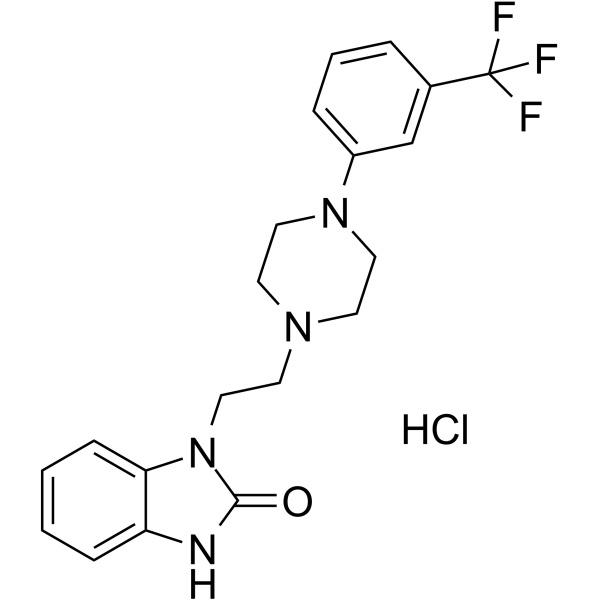147359-76-0
| Name | Flibanserin hydrochloride |
|---|---|
| Synonyms |
Flibanserin HCl
BIMT 17 Hydrochloride 1-(2-{4-[3-(Trifluoromethyl)phenyl]-1-piperazinyl}ethyl)-1,3-dihydro-2H-benzimidazol-2-one hydrochloride (1:1) 2H-Benzimidazol-2-one, 1,3-dihydro-1-[2-[4-[3-(trifluoromethyl)phenyl]-1-piperazinyl]ethyl]-, hydrochloride (1:1) 1-(2-(4-(3-(Trifluoromethyl)phenyl)piperazin-1-yl)ethyl)-1H-benzo[d]imidazol-2(3H)-one Hydrochloride UNII:96XTC36K1B BIMT 17BS Hydrochloride |
| Description | Flibanserin (BIMT-17; BIMT-17BS) hydrochloride is an orally active serotonin 5-HT1A receptor agonist and 5-HT2A receptor antagonist with Ki values of 1 nM and 49 nM, respectively. Flibanserin hydrochloride binds to dopamine D4 receptors with an Ki value of 4-24 nM. Flibanserin hydrochloride shows anti-depression and anti-anxiety effect, can be used to hypoactive sexual desire disorder (HSDD) research[1]-[5]. |
|---|---|
| Related Catalog | |
| Target |
5-HT1A Receptor:1 nM (Ki) 5-HT2A Receptor:49 nM (Ki) |
| In Vitro | Flibanserin hydrochloride (0.01-100 μM; 72 h) can transform into two degradation products DP1 and DP2 with no toxicity potential after oxidative degradation[1]. Cell Viability Assay[1] Cell Line: NHSF cell lin Concentration: 0.01, 0.1, 1, 10, 100 μM Incubation Time: 72 hours Result: Resulted cell viability reached to 97.91% (DP1) and 96.73% (DP2) at 0.01 μM. Showed non-toxic up to 100 μM (IC50 >100 μM). |
| In Vivo | Flibanserin hydrochloride (1, 10, 30 mg/kg; i.p.; single dose) shows different pharmacological properties in prefrontal cortex, hippocampus and midbrain. The 5-HT1A receptor occupancy in cortex indicates it’s the more sensitive than other brain region[2]. Flibanserin hydrochloride (15, 45 mg/kg; p.o.; twice a day; 22 d) preferentially activates the brain regions belonging to the mesolimbic dopaminergic pathway and hypothalamic structures involved in the integration of sexual cues related to sexual motivation[3]. Flibanserin hydrochloride (5, 10, 25, and 50 mg/kg; s.c.; single dose) has anxiolytic effects without locomotor side effects in rat ultrasonic vocalization model[4]. Animal Model: Long Evans female rats (225-250 g)[3] Dosage: 15 mg/kg; 45 mg/kg Administration: Oral gavage; twice a day for 22 days Result: Increased the density of activated catecholaminergic neurons in the ventral tegmental area but not in the locus coeruleus. Increased Fos expression in the medial preoptic area and arcuate nucleus of the hypothalamus, ventral tegmental area, locus coeruleus, and lateral paragigantocellular nucleus with chronic 22-day treatment. Animal Model: Rat pup ultrasonic vocalization model of anxiety[4] Dosage: 5, 10, 25, and 50 mg/kg Administration: Subcutaneous injection Result: Reduced ultrasonic vocalizations in rat pups. Showed effective within 30 min and has no severe locomotor side effects at active doses. |
| References |
| Melting Point | >225°C (dec.) |
|---|---|
| Molecular Formula | C20H22ClF3N4O |
| Molecular Weight | 426.863 |
| Exact Mass | 426.143433 |
| PSA | 44.27000 |
| LogP | 3.97550 |

